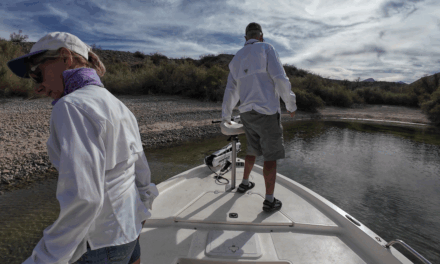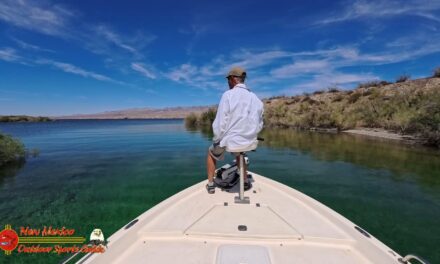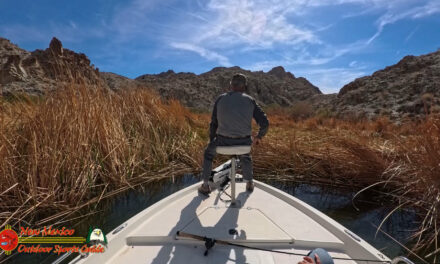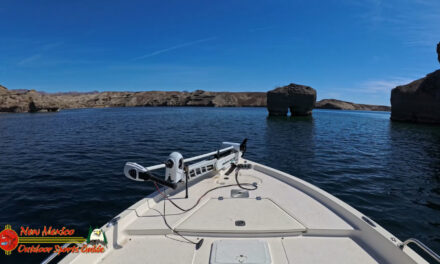| Dead-Sticking Bass By Steve vonBrandt |
 When
Whenthe weather is nasty, be it in the early spring or late fall, many
anglers miss out on some of the best bass fishing of the year. When
their boats are in the garage, and their gear is stored away, other
anglers in the know, cash in on some of the best fishing of the year
using some special techniques. One of the most effective ways to catch
big bass in colder water, is a technique known as “Dead-Sticking.” The
anglers who can brave the elements and employ these techniques, catch
some of the largest bass of the year.
– Lake Mohave
“Dead-Sticking Technique”
The
name of the technique tells it all. The technique actually involves
more patience than action. Some of the best ways to present a bait
using a Dead-Sticking technique are Drop-Shotting, using a suspending
jerkbait, and fluttering soft plastics to the bottom. These are great
ways to tempt early season and late season bass. You won’t catch a ton
of bass in really cold water, but you can have a memorable day, and
catch some of the larger bass of the year. When the water temperature
is in the low to mid forties, shad and herring either die off in the
winter, or they are so lethargic, that they are a good target for
feeding bass. A lure that suspends at the level of the bass, or just
falls slowly to the bottom, or in the case of the drop-shot, just sits
still in the middle of the water column, offers a tempting imitation of
a dying shad.
name of the technique tells it all. The technique actually involves
more patience than action. Some of the best ways to present a bait
using a Dead-Sticking technique are Drop-Shotting, using a suspending
jerkbait, and fluttering soft plastics to the bottom. These are great
ways to tempt early season and late season bass. You won’t catch a ton
of bass in really cold water, but you can have a memorable day, and
catch some of the larger bass of the year. When the water temperature
is in the low to mid forties, shad and herring either die off in the
winter, or they are so lethargic, that they are a good target for
feeding bass. A lure that suspends at the level of the bass, or just
falls slowly to the bottom, or in the case of the drop-shot, just sits
still in the middle of the water column, offers a tempting imitation of
a dying shad.
“Jerkbaits”
 There are many good Jerkbaits on the market today, but for dead-sticking techniques I like certain baits more than others. Smithwick Rogues, Lucky Craft Pointers, and Rapala Husky Jerks, and Strike Pro USA are among my favorites.
There are many good Jerkbaits on the market today, but for dead-sticking techniques I like certain baits more than others. Smithwick Rogues, Lucky Craft Pointers, and Rapala Husky Jerks, and Strike Pro USA are among my favorites. They
are excellant baits for dead-sticking because they suspend. You can
throw them out, reel them down, and play the waiting game. I have done
this, and many times, while getting a drink, or grabbing something to
eat, the bass have hit the bait. Sometimes it takes as long as a
minute, or even two, before a bass will move up to a suspending bait
and decide to hit it. I throw the baits way past the target, and jerk
it down to where I think the bass are. In some bigger lakes and
reservoirs I like to fish any standing timber they have available. I
jerk the bait down, and then stop it right by a tree. I then let it sit
as long as a minute before moving it again.
are excellant baits for dead-sticking because they suspend. You can
throw them out, reel them down, and play the waiting game. I have done
this, and many times, while getting a drink, or grabbing something to
eat, the bass have hit the bait. Sometimes it takes as long as a
minute, or even two, before a bass will move up to a suspending bait
and decide to hit it. I throw the baits way past the target, and jerk
it down to where I think the bass are. In some bigger lakes and
reservoirs I like to fish any standing timber they have available. I
jerk the bait down, and then stop it right by a tree. I then let it sit
as long as a minute before moving it again.
Many times
the bass will hit while it is sitting still, or when I first start to
move it again. This happened to me quite a few times in Greenwood Lake
and in Union Lake, in New Jersey. It is an excellent way to catch cold
water bass in these and other lakes. I had great success with this
method on Table Rock Lake, and Bull Shoals in Missouri, working the
standing timber.
the bass will hit while it is sitting still, or when I first start to
move it again. This happened to me quite a few times in Greenwood Lake
and in Union Lake, in New Jersey. It is an excellent way to catch cold
water bass in these and other lakes. I had great success with this
method on Table Rock Lake, and Bull Shoals in Missouri, working the
standing timber.
It doesn’t really matter if it’s a
tree, or rocks, or next to a dock. The trick is to let the bait sit
there for as long as it takes, without moving it all. A lot of anglers
are tempted to impart some action to the bait, but this is a mistake.
This is the time to wait as long as you can stand it. Nerves of steel
are required for this type of fishing.
tree, or rocks, or next to a dock. The trick is to let the bait sit
there for as long as it takes, without moving it all. A lot of anglers
are tempted to impart some action to the bait, but this is a mistake.
This is the time to wait as long as you can stand it. Nerves of steel
are required for this type of fishing.
Another good
location to use this technique is over old roadbeds, like in Spruce Run
reservoir in New Jersey. I also like to use them along bluff walls, and
across long tapering points. When the water starts to warm in the
spring, or after a warm spell in the winter, bass will move up from the
deeper water and suspend over or near these areas. These are ideal
baits to use to entice them into striking. I like to find a long flat
point, near a creek channel, where the deep water isn’t far from the
shallow water. This is where the bass will be, due to the fact that
don’t have to move very far, which is important this time of year, but
especially true in the winter.
location to use this technique is over old roadbeds, like in Spruce Run
reservoir in New Jersey. I also like to use them along bluff walls, and
across long tapering points. When the water starts to warm in the
spring, or after a warm spell in the winter, bass will move up from the
deeper water and suspend over or near these areas. These are ideal
baits to use to entice them into striking. I like to find a long flat
point, near a creek channel, where the deep water isn’t far from the
shallow water. This is where the bass will be, due to the fact that
don’t have to move very far, which is important this time of year, but
especially true in the winter.

When bass are suspending, if you throw a carolina-rigged bait, you are
actually fishing under the bass, if you use a crankbait, you’re usually
fishing too fast. This is why suspending jerkbaits are ideal, because
they get right down into the suspended bass and stay in one place. This
is even more important in the winter, than the early spring. I make
sure I fan cast the entire structure from many different angles. Many
times the bass don’t hit the bait until it is presented at just the
right angle, and you won’t know what that is until you make enough
casts to start catching fish.
The most strikes occur in
about eight to ten feet of water, and suspending baits that go down to
about eight feet are the best. You need at least two feet of visibility
for dead-sticking baits, and more is preferable. It is very important
for them to be able to see it, as you are not moving the bait, and it
doesn’t make much noise. My best days deadsticking have been on lakes
with a good degree of visibility.
about eight to ten feet of water, and suspending baits that go down to
about eight feet are the best. You need at least two feet of visibility
for dead-sticking baits, and more is preferable. It is very important
for them to be able to see it, as you are not moving the bait, and it
doesn’t make much noise. My best days deadsticking have been on lakes
with a good degree of visibility.
“Dead-Sticking Soft Plastics”
Most bass fisherman use Zoom Flukes, Bass Assassins,
and other soft plastics, with a twitch, twitch, reel twitch action,
like in the warmer months, but using these baits with a dead-sticking
technique in the colder water, works wonders. Bass won’t come up and
hit these baits on or near the surface when it’s cold, but they do hit
it when it falls slowly to the bottom. It takes so much patience to
work these baits right in cold water that most anglers don’t have the
patience it takes to work them properly. I use the bait on a unweighted
4/0 or 5/0 WG hook, and let it fall slowly to the bottom. The bait only
sinks about one foot every three to four seconds, and this is perfect
to imitate a dying shad. I have had the best luck with this in the
winter, but in the very early spring, it can be effective also. I just
cast it out next to the structure, whether it’s a dock, or brushpile,
or just over some type of structure that the bass are suspending on. I
might twitch it a couple of times as it falls, but not too much, just
enough to convince a bass that it is crippled or dying. It is a great
bait for areas that have a lot of dying shad in the winter.
and other soft plastics, with a twitch, twitch, reel twitch action,
like in the warmer months, but using these baits with a dead-sticking
technique in the colder water, works wonders. Bass won’t come up and
hit these baits on or near the surface when it’s cold, but they do hit
it when it falls slowly to the bottom. It takes so much patience to
work these baits right in cold water that most anglers don’t have the
patience it takes to work them properly. I use the bait on a unweighted
4/0 or 5/0 WG hook, and let it fall slowly to the bottom. The bait only
sinks about one foot every three to four seconds, and this is perfect
to imitate a dying shad. I have had the best luck with this in the
winter, but in the very early spring, it can be effective also. I just
cast it out next to the structure, whether it’s a dock, or brushpile,
or just over some type of structure that the bass are suspending on. I
might twitch it a couple of times as it falls, but not too much, just
enough to convince a bass that it is crippled or dying. It is a great
bait for areas that have a lot of dying shad in the winter.
One of the baits that I have had the most success with last year using these dead-sticking methods, is the Yamamoto “Senko.”
This bait is perfect to use dead-sticking. Although it is nothing more
than a thin, straight piece of plastic when it is out of the water, it
literally comes alive with just the right action to entice bass in
colder water. The new “Netbaits”
have also worked very well this year, as have the “Bearpaws” “Lazy
Sticks”. It is perfect for letting sink slowly to the bottom, or for
drop-shotting. Because of the salt content in these baits, it sinks a
little faster than an unsalted lure. These baits are perfect for a lot
of different situations, as long as you have to patience to let them
sink. You really don’t have to do anything to these lures, except let
them sink slowly on a slack line. I rig them on a 2/0 or 3/0 Daiichi or X-Point hooks,
on fourteen pound test Spiderline Super Mono, or P-Line.The trick is to
pay very close attention to the line, sometimes you might feel a bite,
but generally you will not. I just move the rod tip a little bit to see
if I can feel the weight of the bass. If I can’t, I just let it fall
slowly to the bottom again. The action really comes when the bait is
falling, so you have to lift the rod slowly, and let it fall back again
as you work it across the bottom. There is even a new larger Senko for
this year that I am looking forward to using. Even the new Cut-Tail
worm may work well in these cold water situations, and I am looking
forward to trying them out this year.
This bait is perfect to use dead-sticking. Although it is nothing more
than a thin, straight piece of plastic when it is out of the water, it
literally comes alive with just the right action to entice bass in
colder water. The new “Netbaits”
have also worked very well this year, as have the “Bearpaws” “Lazy
Sticks”. It is perfect for letting sink slowly to the bottom, or for
drop-shotting. Because of the salt content in these baits, it sinks a
little faster than an unsalted lure. These baits are perfect for a lot
of different situations, as long as you have to patience to let them
sink. You really don’t have to do anything to these lures, except let
them sink slowly on a slack line. I rig them on a 2/0 or 3/0 Daiichi or X-Point hooks,
on fourteen pound test Spiderline Super Mono, or P-Line.The trick is to
pay very close attention to the line, sometimes you might feel a bite,
but generally you will not. I just move the rod tip a little bit to see
if I can feel the weight of the bass. If I can’t, I just let it fall
slowly to the bottom again. The action really comes when the bait is
falling, so you have to lift the rod slowly, and let it fall back again
as you work it across the bottom. There is even a new larger Senko for
this year that I am looking forward to using. Even the new Cut-Tail
worm may work well in these cold water situations, and I am looking
forward to trying them out this year.
“Drop-Shotting”
The
best technique to come along for cold water or suspending bass is the
Drop-Shot technique. Drop-Shotting can tempt bass into striking in the
cold water at all times of the year. In the late winter, or very early
spring, I just cast it out, let it hit the bottom, and tighten my line
up. I use very little action at all. I don’t really shake my rod tip or
anything, I just let it sit.
best technique to come along for cold water or suspending bass is the
Drop-Shot technique. Drop-Shotting can tempt bass into striking in the
cold water at all times of the year. In the late winter, or very early
spring, I just cast it out, let it hit the bottom, and tighten my line
up. I use very little action at all. I don’t really shake my rod tip or
anything, I just let it sit.

The less action the better! I do fish them around some structure also,
and generally when I do this I work the bait with a little more action
up to the cover, and then just let it sit when I get next to it. It is
a very effective method in the winter or spring.
I generally use a
three to four inch bait on drop-shot rigs, but other baits have worked
at different times. The hardest part of fishing in the winter or very
early spring isn’t the fishing itself, but motivating yourself to get
out there and go when the weather is less than desirable.
This
is where the patience comes in, as it is very hard to sit still for
long periods of time, and work the bait as slowly as is necessary to
produce the strikes. Dead-Sticking really works if you remember exactly
what it means. I like to use a high modulus graphite rod for the
Dead-Sticking techniques, in a 6 1/2 to 7 foot length, with twelve to
fourteen pound test line. I use spinning gear on little finesse baits,
or a light line baitcaster. I use a baitcast rod, and up to fourteen to
seventeen pound test line, in the deeper water, and for larger baits.
Try these techniques this year, and your recreational and tournament
fishing will improve greatly.
is where the patience comes in, as it is very hard to sit still for
long periods of time, and work the bait as slowly as is necessary to
produce the strikes. Dead-Sticking really works if you remember exactly
what it means. I like to use a high modulus graphite rod for the
Dead-Sticking techniques, in a 6 1/2 to 7 foot length, with twelve to
fourteen pound test line. I use spinning gear on little finesse baits,
or a light line baitcaster. I use a baitcast rod, and up to fourteen to
seventeen pound test line, in the deeper water, and for larger baits.
Try these techniques this year, and your recreational and tournament
fishing will improve greatly.
www.reeltimeanglers.com
www.delawaretackle.com – Lake Mohave






